Dei Precision Shepherds Reg'd
The German Way!
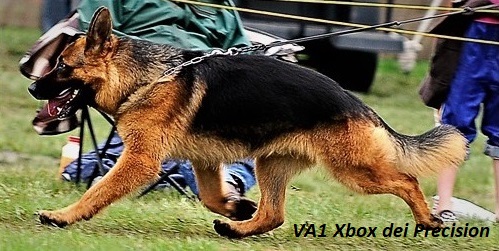
|
This article has been reproduced with the kind permission of the author.
STRENGTHS & WEAKNESSES
OF THE MODERN GERMAN SHEPHERD DOG
LECTURE BY
PETER VAN OIRSCHOT
Supervisor Breed Affairs S.V. Netherlands.
Introduction
I would like to thank the GSD Breed Council and the Educational Working Party, your Chairman the honourable Mr. Percy Elliott,
Secretary Mrs. Sheila Rankin and my colleague, the international judge, Mr. Brian Wootton
for the invitation to have a conversation about topics in the breeding, keeping, working and showing of GSD in the 21st Century.
Firstly I want to introduce myself to you. My name is Peter van Oirschot; I have admired dogs from childhood. The most impressive
birthday present I ever received was on my 12th birthday. It was a purebred GSD bitch and from that time I became involved in the breed.
In l968 my kennel affix was registered "Van de Herderskring" and I became a youth member of both VDH-NL and SV Germany. I have trained
about 12 different dogs for SchH and have had different tasks in VDH Vereeniging van Fokkers en Liefhebbers van Duitse Herdershonded
(my society for breeders and enthusiasts of the GSD) in the Netherlands. In l984 I became a GSD Judge appointed by the Kennel Club NL
and SV Zuchtrichter appointed from the SV Germany. In l988 I became
Kormeister VDH Netherlands and since l990 I am Breed Warden (Vereinschzuchtwart supervisor Breed Affairs) of the VDH Netherlands.
My career within the GSD scheme you can call classic, starting from the bottom and based on practical experience. I work with GSD, I breed
them, I show them and I spoil them. I am very lucky to meet GSD people all over the world and to share with them the common enthusiasm
and sincere involvement with our breed. I felt, and still feel, a deep respect for the working Shepherd dog: searching for mines and
explosives, as a rescue dog, tracking using his senses and intelligence and alertness in a variety of tasks as helpers for mankind, the
embodiment of man's best friend. Though, maybe his most important duty is his source of joy in thousands of homes as a lovely, reliable,
intelligent companion.
Secondly, Mr. Brian Wootton gave me three interesting themes to start up the discussion:
1. Strength and weaknesses of the modern GSD, actual animals and bloodlines and, of course, an open interaction and discussion about
this theme, guided by your Chairman.
2. We will refresh our knowledge about conformation, why and what are we judging? Do we as judges do our utmost to fill
in aspects of health, soundness, working abilities in conformation, standard type, how do we judge and why? We will refresh our
knowledge by watching a video and discussing it. Is modern judging going for the cosmetic dog or do we have other aims?
3. The GSD; Is it a divided breed? Strength and weaknesses in continental breeding and showing.
PART 1: STRENGTH AND WEAKNESSES OF THE MODERN GSD: ACTUAL ANIMALS AND BLOODLINES
This is not a new subject. As history is a discussion without ending and every generation and its time has to respond to the actual
situation by putting their own questions and use history to answer them and to show responsibility, we also have to ask new questions
and show responsibility to this subject,strength and weaknesses of the actual bloodlines in our breed.
BLOODLINES: What do we mean? A bloodline is formed by mostly an influential sire through inbreeding and line breeding that gives his
characteristics to a range of related offspring. The Germans use the word "Hochzucht" and this involves breeding with the best dogs: the
breeding lines and families of dogs which in a period are the best representatives of the breed. This culminates in the most important events
in the GSD world, particularly the major shows. Landsgruppen and Sieger Shows in different countries; with the top being the main breed show
in the country of origin: the Hauptzuchtschau in Germany. Those dogs, lines and families which can perform there and their descendants
belong to the Hochzucht. This system has dominated German Shepherd Dog breeding for decades and has a worldwide influence on the breeding
of our breed. In this system we must remember, Sires have the most influence upon the population. Dams (performing bitches) are the most
important for the individual success of the breeder (kennel).
This modern GSD is a product of this Hochzucht. Several very good books in Britain have dealt with its history; you know for instance the
writings of Malcolm Willis and Brian Wootton. From these books we learnt that each period of time had to deal with its own problems with
the breed. Too many youngsters have a romantic view of the past. The truth is that in the early years of the making of the breed this new
breed was looking like an ugly crossbreed among the established "luxury" show breeds. In the early 20th Century inbreeding and line breeding
made quick progress. Inbreeding is combining animals that are closer related than the average of the population. Close inbreeding is
combining parents-children; (half) brothers (half) sisters. Line breeding is combining within the 3rd, 4th or 5th generation. In the
1920's of the 20th Century there were a lot of severe problems in character and the Nazis abused these working "qualities" for purposes we
don't want to talk about. It took a very long time to get rid of this very bad image. When we compare the development of our breed we
notice a change in overall type and construction. There is a big difference in other breeds where the standard has been frozen
to ideal representatives and an ideal image of the breed set in the past. The architect of the GSD, Max Von Stephanitz constructed
a visionary standard to be reached in the future. When he died his work was not finished. His testament was to maintain the
GSD as a suitable working dog with a scale of new tasks as a helper of mankind in appearance and temperament based on the excellent
mental qualities of the herding dog in the continental meaning of sound in body and spirit.
The subject of bloodlines in the past gave us the debate about what is the right type? We have at this
moment a common opinion about
the standard type. The questions we have to answer now are:
1. How about this standard type in the present day.
2. How about the soundness of the breed; its health, its performance, its image?
3. How about the GSD as a suitable working dog; helper of mankind?
4. How about the harmony between appearance and temperament and the
excellent mental qualities:
sound in body and spirit?
|
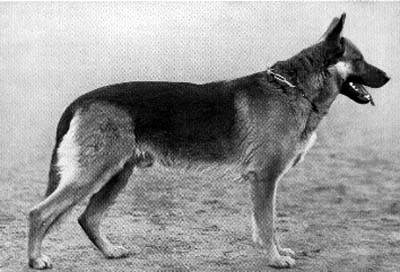
Utz v Haus Schuetting
|
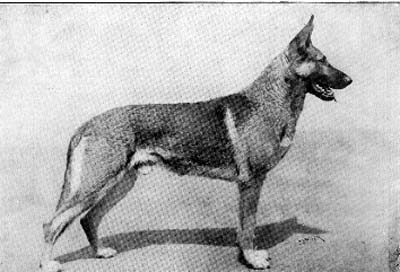
Klodo vom Boxberg
|
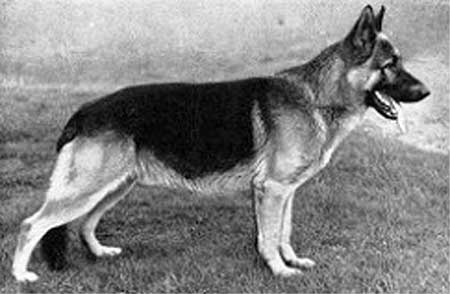
Rolf von Osnabrueckerland
|
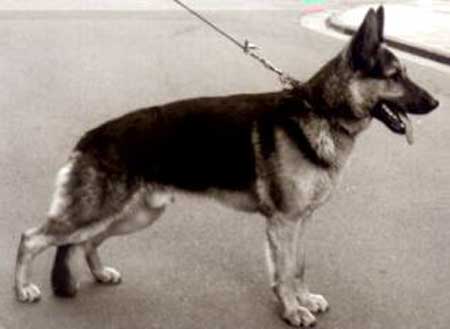
Alf vom Nordfelsen
|
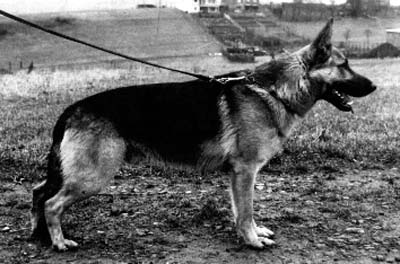
Jalk Fohlenbrunnen
|
STANDARD TYPE:
The development of the standard type can clearly be demonstrated by looking to dogs such as: Sieger
1925 Klodo v Boxberg: He was in his day a turning point for the problems in his time and he was a
surprising Sieger. He marked the standard type of a more stretched medium sized dog in a period when
the dogs were large, square, high legged and the temperament had deteriorated. Von Stephanitz
surprised the GSD scheme when he gave the German title to the sable Czechoslovakian Sieger who gave
good temperament but many long coats.
Sieger 1929: Utz Haus Schuetting was a turning point also. He dominates the bloodlines in the Hochzucht
and since Utz, Schwarz-gelb (black & gold) is in and sable is out. The origin of the sable colour is found
in lines without Utz. Utz is criticised because of lack of temperament and teeth problems.
VA 50/51 Rolf Osnabruckerland and Sieger l955 Alf Nordfelsen are an example of successful complimentary breeding.
VA l962/63 Jalk Fohlenbrunnen, the Siegers & VA of the seventies, the big three, Quanto Wienerau, Canto Wienerau,
Mutz Peltzierfarm. Quanto/Canto Wienerau are examples of complimentary breeding and successful inbreeding:
L-litter Wienerau - VA Jalk Fohlenbrunnen.
|
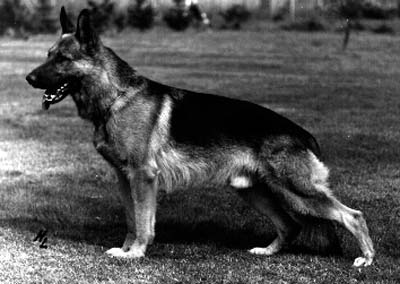
Canto von der Wienerau
|
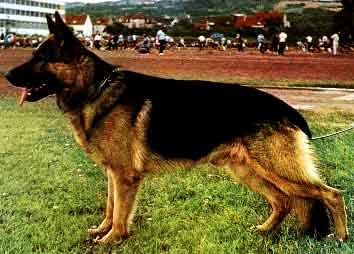
Quanto von der Wienerau
|
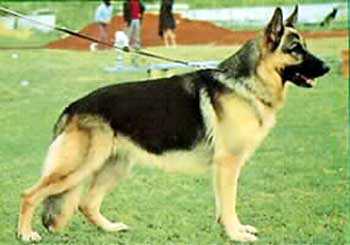
Mutz von der Pelztierfarm
|
Mutz Peltzierfarm formed a very good combination with Quanto Wienerau. Mutz gave
good working temperaments and masculinity. As a direct sire-line his influence is disappearing.
The 1980's brought the bitch Palme Wildsteiger Land as a source of success for Wildsteiger Land kennels through her
sons: Siegers Uran Wildsteiger Land and Quando Arminius. She has had a major influence on the breed.
The Q-litter Arminius with Sieger Quando brought the legendary Odin Tannenmeise. With the Q-litter
Arminius/Uran Wildsteigerland (Palme), Odin Tannenmeise (Quando A) and Cello Romerau (Quana A) the inbreeding
is getting narrow now and this PALME/URAN/QUANDO/ODIN/CELLO family has brought us into the 1990's up to the present
days:
Ulk Arlett, Ursus Batu, Yasko Farbenspiel.
|
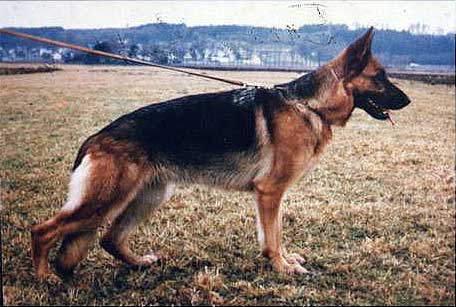
Palme vom Wildsteiger Land
|
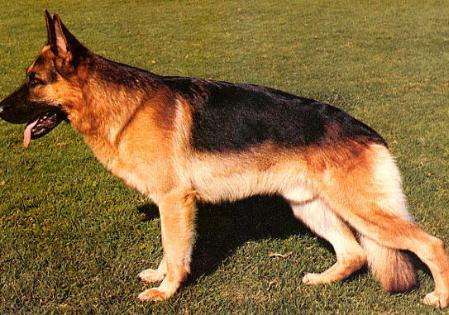
Uran vom Wildsteiger Land
|
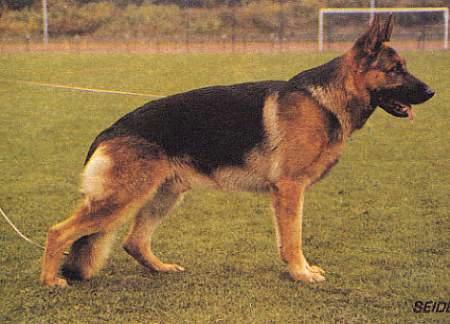
Quando von Arminius
|
Looking to the above mentioned dogs we can conclude that there is a clear comparison in standard type without exaggerations
(uebertypisierung) that we can see in the American standards and the Alsatian-type. We don't want a cosmetic dog. GSD breeding
is not nice, nicer, nicest. A Zuchtschau is not a beauty contest. We also can conclude that the period of the brothers Walter
(Wienerau) and Hermann (Arminius) Martin brought more uniformity in the Hochzucht breed. As we ask ourselves do we breed according
to the standard ideals of the visionary Von Stephanitz?
I think that in our day there is a warning: to want more can mean to get worse.
We have indeed improved, in general, the standard type of the GSD. I think we saw the highpoint of breeding in the 1980's for instance
in the Quanto Wienerau line via Quando Arminius to Odin Tannenmeise and in Uran Wildsteiger Land. But every advantage brings along its own
disadvantage. We got uniformity in genetic make-up and that means loss of genetic variation. Uniformity in type but also uniformity in pigmentation
sometimes means less pigmentation. Hochzucht breeding became a matter of copying the successful formula of successful breeders; doing more of the same.
The demand for type was a demand for the predominant type set by the world famous kennel "von der Wienerau". To deviate from this type was
to deviate from the Hochzucht breeding.
Hochzucht developed into a one way street.
If we have to criticise we must do it according to the aims of the standard:
* Angulations of the forehand, especially the lay of the shoulder blade and forehand reach.
* Clear distinction in sex characteristics between males and females.
* Rich pigmentation
* The athletic dog, height and overall body weight
* The outlines, specially straight back and correct long underline
* Length and height proportions
* A balanced dog without exaggerated hind angulations. Well-developed thighs in hindquarters
in proportion to the middle piece and the forehand angulations.
* Correct front and chest development
* Correct joints, elbows, hocks and correct coming and going.
For a suitable working dog this means gaiting in harmony and endurance but also enough ground speed, running, galloping, springing, sitting,
turning easily. Not oversized, overweight, coarse appearance, lack of firmness. Of course, a champion must show spirit
in appearance and charisma. A breed dog must behave himself like a perfect gentleman, be reliable and self- confident.
Where there is sun there is also a shadow. The 1990's until the present day brought us also a GSD on the upper limit of height and weight.
A lot of criticism was of the topline, overstretched bodies, roached backs, sloping backs, unbalanced dogs, steep upper arms in
combination with over angulation of the hindquarters and bad fronts, elbows and cow hocks. How can such dogs get excellent places
even at a Hauptzuchtschau? Because typey dogs with roomy gaits seen from the side and handled by experts can impress!
Exaggerations are waiting around the corner, sometimes it is wiser to maintain than to improve.
Take for instance the problems of soft ears, oversize, soft temperaments, upper arms, fronts
and look to some of the most influential producers:
* Palme Wildsteiger Land - oversize, ears
* Uran Wildsteiger Land (Palme) dwarfs, ears
* Quando (Q litter) Arminius (Palme) oversize, front/upper-arms, lacking hardness (Belastbarkeit)
* Cello Romerau (Quana A) oversize, ears, upper arm
* Odin Tannenmeise (Quando A) - 65cm/ears, temperament (lazy)
|
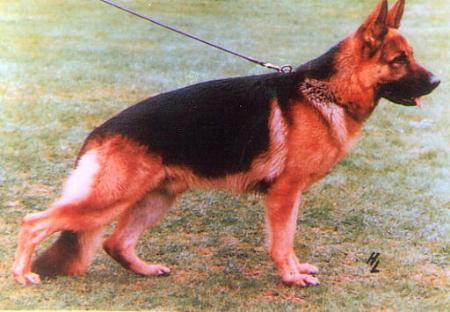
Odin v Tannenmeise
|
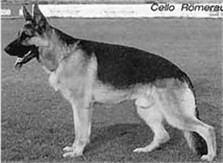
Cello von der Roemerau
|
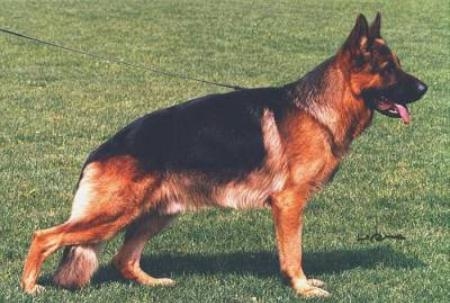
Ursus von Batu
|
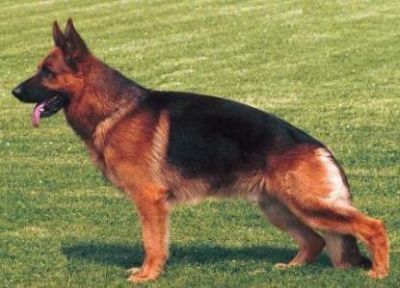
Yasko vom Farbenspiel
|
Size, ear problems, temperament failures; perhaps some health, physical and genetic problems are possibly a result of continuing family breeding
and inbreeding while ignoring the problems.
Hochzucht became one big family. We see this in the pigmentation. In temperament; we certainly improved the breed. The GSD became friendlier
but also a softer dog, less hardness means also more suitable as a pet but also more dogs become dull, lacking in spirit and some are affected
by stressful situations. In general, the temperaments are more reliable and certainly not dangerous or shy, but those friendly, soft dogs
in stressful circumstances lack hardness, spirit and endurance, and they cannot bring us what we want from a multi-purpose working dog.
Can we blame our Hochzucht dog for the sins of his family? That does not mean that he has not a good character
but that sometimes we miss something...
Actual problems stated by Mr. P. Messler SV President in his annual report
* Health: HD/ED - problems in the back region
* uebertypisierung: overangulation - without stability in the hindquarters in
stance/movement.
* Too little attention given to general appearance, too much emphasis on details.
* Problems of oversize, weight, pigmentation.
* Colour (Type) diversity, genetic diversity.
* More genetic diversity, more health and vitality. Too much emphasis on
uniformity of general appearance.
A DIVIDED BREED?
In his annual report (2002) Mr. Messler states: Within the SV are two populations of German Shepherd Dogs. A population consists of
a range of animals that are related. There is a clear distinction between Hochzucht and Leistungszucht (working lines).
Leistungszucht have common related animals that are selected through national and state trials and are supported by working
dog people. In short, this is resulting in polarisation within the SV and self-interested pressure groups: breeding for their
own market and having a specific interest in the puppy market. To put it simply, there are two groups: show people versus
working dog people. If you compare the direct sire-lines of the VA/V males of the Hauptzuchtschau 2002 you will notice a difference
in the lines with Utz Haus Schuetting and those without Utz and the percentage of sable dogs. If you compare the appearance of the
two populations you will also see clear differences concerning size, weight, type general appearance and pigmentation. There is a
difference in genetic make up. In general the working dog lines cannot meet the high standard the Hochzucht has reached in anatomy,
according to the standard and the Hochzucht has, in general has problems with the drives and instincts which are considered essential
to reach high working performances. This polarisation results in different kinds of local groups (Ortsgruppen) and a separation between
the delegates in the general meeting. Mostly the silent majority of pet owners are not represented. Clearly there is a crisis in breeding
aims and policy within the SV and a loss of thousands of members.
We spoke about the problems concerning the Hochzucht breeding but there is certainly a crisis in the Leistungszucht breeding too. In this
breeding also we see that bloodlines are becoming narrow due to selected inbreeding on four or five predominant animals or lines. A lot
of working dogs have problems in reaching the minimum grading "Good" not to mention the qualities to get a Breed Survey Class l. Also in these
lines we see health and physical problems. The real crisis though is that the present working dog breeders cannot fulfil the standards of the
breeding animals that form the roots of their pedigrees. There was a time when there was a one undivided breed, VA and V Class l dogs
Hauptzuchtschau and LG Schau such as: VA Bernd Lierberg, VA Seffe Busecker Schloss, VA Mutz Pelztierfarm, VA Frei Gugge and V dogs like
Nico Haus Beck, Mike Bungalow, Greif Lahntal and several Busecker Schloss dogs etc. These are the roots of the present working dogs lines
and fulfilled the universal aims of the standard and belonged to the Hochzucht too. The present day working dog breeder should follow the
example of the Altmeisters of the past. Must they be satisfied with less? The polarisation is doing the whole GSD breeding harm. Separation
and exclusion is not sensible and clouds the debate about the future of the GSD "made in Germany", the leading position of the SV within the WUSV
and the overall quality of the breed throughout the world.
The Undivided Era
|
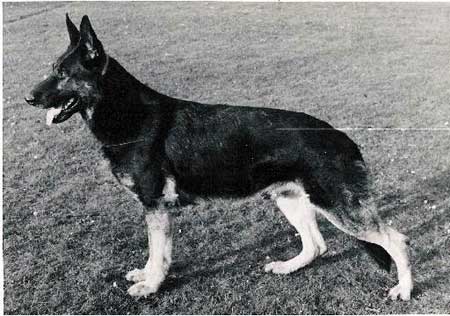
Bernd vom Lierberg
|
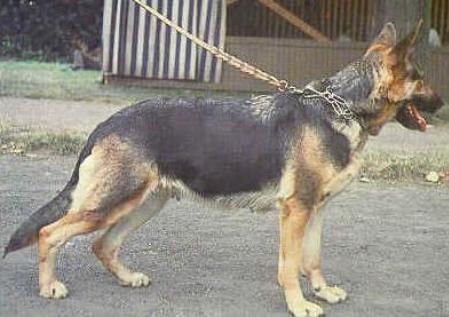
Seffe vom Busecker Schloss
|
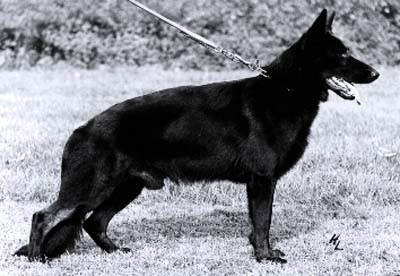
Frei von der Gugge
|

Nico vom Haus Beck
|
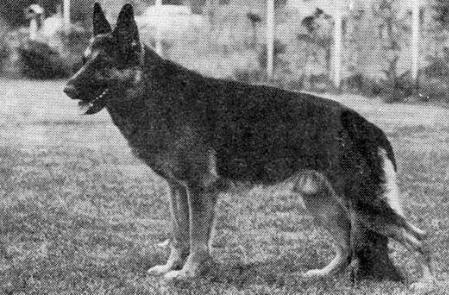
Mike vom Bungalow
|
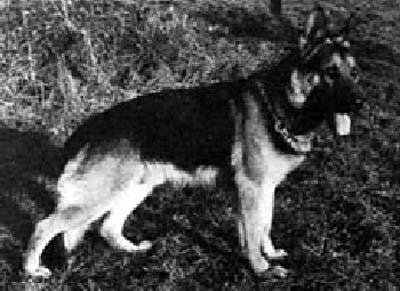
Greif zum Lahntal
|
The world and society has changed. The most important task of a GSD is his role as a companion dog in a complex environment.
Dr. Malcolm Willis (1998) states: Type traits and behaviour traits are the most important traits in dog breeding. Of course we all
accept the priority concerning health and maintenance of soundness, also when our dogs are becoming old (fitness traits). Willis states
that it is a basic principle of animal breeding that the more traits one seeks to include in a breeding programme the harder the task will
become. I truly think we exclude too many potential breed animals both in Hochzucht and Leistungszucht because of narrow mindedness and
because we are selecting in a one-way street. For instance, if a dog is not absolutely top in show (VA) we don't prefer him as a breeding
partner because of the puppy market. The same goes for the working dog people; the dog must have a high profile in the working dog scene.
In fact we are perhaps excluding the more desired dogs if we consider the whole range of traits which we demand from a GSD suited to live
or even survive in our time.
After checking one year of breeding in the Netherlands, the scientific Hirschfeld Foundation of the Dutch Kennel Club, in co-operation
with the Dutch German Shepherd Dog Club, concluded in their report of l997 that in general, there were less health problems than was expected
but that behavioural problems scored the highest among the owners of GSD in the Netherlands.
These problems were
l. Aggressiveness
2. Shy/nervous
3. Disobedient/unmanageable
4. Hyperactive, very noisy
In 2002 the Dutch SV formed a committee to advise about the problem of the forbidden use of the electric collar in the training of dogs.
This committee identified a growth in the use of the forbidden electric collar in training and stated that there was a connection with too
extreme breeding. The Breed Surveyors were advised to be very alert and exclude the animals that behaved unmanageably or showed a tendency
to aggressiveness. That brings us to the question; If we want to improve the temperaments and use the instrument of the Breed Survey (K�rung)
should this be done by a more severe courage test (combative spirit) or must we have improved behavioural testing? Is demanding a harder
courage test by working judges the solution?
At least we should debate it and not leave it to a delegate meeting of the SV where delegates are deciding in a polluted atmosphere of polarisation.
For instance at a Breed Survey in Holland in December 2002 conducted by myself, I breed surveyed over 40 GSD. The majority came in Class
2. I saw some extraordinarily good GSD in the courage test. On the same day DNA testing was carried out in a small room by a Vet.
The dogs had to enter an overcrowded canteen. Afterwards I was told that some of the dogs which did extremely well in the courage test and had high
standards in the trials, behaved very nervously when testing for DNA. Some dogs could not be tested without being muzzled. The basic temperament
(Weser) is not tested in a courage test. I would prefer to leave the ring with normal in a courage test and excellent behaviour in the above mentioned
situation in DNA testing. Another problem is the changed criteria of SchH or VH or IPO training not to the dog but to its owner. I can tell you that
to train a GSD to obtain Sch Hl will take you a year with training twice a week. You need good instructors and well-trained helpers. In the present
day where people have a lot of obligations this demands a lot of a person's time and abilities, especially if they have to wait for their turn for
hours at the training grounds. Are we testing the abilities of the dog or the trainer? How many potentially good dogs are we excluding? The IPO
in the present day demands a lot of perfection in obedience. Obedience has become the most important in bite work too.
Dr. Margaret Pfleiderer Hogner concluded in her dissertation (Munich 1979) and doubted if obedience is a genetic trait. But I fully agree with Willis (l998).
l. Failure to train and work functional dogs can have damaging consequences on
behaviours.
2. Selection for physical beauty will be of minimal value unless associated with
functional ability and those breeds which have preserved working qualities
should be selected to enhance, not lose those virtues.
3. With Willis, I think the breed survey is an important instrument in which dogs
are measured and assessed against the breed standard but including some
evaluation of character/work.
I think the statement in the WUSV (Annual Report WUSV meeting 9th September, Karlsruhe 2002) should be incorporated by all WUSV member organisations.
Minimum criteria for a start programme
1. Testing social behaviour to people and animals; (the Swiss temperament test).
Environment testing (acoustical and optical). Gun sure test. Prey drive with the
sack
2. Companion Dog certificate (BH)
3. Tracking disposition
Messler states in his WUSV report "Working is for the GSD essential". To be kept only in a kennel is a torment to the soundness of his spirit
and body. I personally think we must find several jobs for our GSD to maintain his
position as a Helper of Mankind.
My advice and wishes are that GSD breeding stops excluding, separatism and division. More common sense please. No one-way street but overall
selection of overall traits. The right combination is not extreme mated to extreme. Hochzucht must include Leistungszucht and vice versa. Sometimes
it will be proved that the dog you want to exclude can be in fact the one that you needed the most. That means also more genetic variety. We do not
need incrossing of other breeds as stated by Helmut Raiser at the discussion evening in Viernheim 2003. I think we need a European Breed Affairs Committee
with excellent geneticists and very experienced breeders that can stop the nonsense.
STRENGTH AND WEAKNESSES OF THE CONTINENTAL SHOWING AND BREEDING
SYSTEM
THE STRENGTH The SV is a very well organised and professionally managed organisation. There is a framework of local clubs, experienced
instructors, helpers and well-trained judges. The quality of the breed in general is high and at the moment the standards have reached such high peaks
that further improvements can lead to exaggerations. The SV controls and manages the GSD breeding and protects the interest of the GSD in Germany. The SV
dominates the WUSV but this is possibly due more to a weakness of the other associated members! The initiatives in HD, especially the Breed Value system,
the ED scheme and DNA programme deserve our admiration. The Hauptzuchtschau and Bundessiegerpruefung are well organised mega events. Before we mention the shadows,
we must conclude
there is a lot of sunshine.
THE WEAKNESSES
Obviously in breeding we have at the moment a bottleneck both in Hochzucht and Leistungszucht and a lack of genetic diversity. Mr. Messler was not able to
stop this and to introduce alternatives. Hopefully Orschler can find them in or outside Germany. The German Shepherd Dog is not only the Wienerau/Arminius type.
There are too many pressure groups in the show world. You see teams sometimes operating as Cartels, having too much influence on the individual choices in breeding
and showing. Sometimes there is a tendency to control the market and to influence the show world by excluding others. There is not always equality of chances.
There is a tendency amongst well-informed judges to make their decisions on self-fulfilling promises. The Hauptzuchtschau is too much a "nice-nicer-nicest" scheme
and less a Zuchschau. The criteria of the progeny groups must be revised. The Hauptzuchtschau should be more a world show of the WUSV. Now it functions too much as
a German shop window for German breeding. Bureaucrats and too many rules give advantages for privileged groups and leads to a form of protectionism for their own
national interests and conflicts with the ideas of a WUSV. In Europe we sometimes forget the common owner of a GSD. We must see the whole scene with his eyes and
do something about it so that he can participate. We must improve the image of the GSD in our present society. If the GSD is a working dog we must offer more
than only Schutzhund or IPO. There is a distinction in SPORT and BREEDING. At this moment high demands in Leistungssport are set as criteria for showing and breeding.
Are these demands put to the owner/trainer (sport) or do they really serve breeding goals? In showing sometimes the image (achievements in the past) of a dog
decides the outcome and not the actual presentation. Is it possible to beat a Sieger in the show ring? There has to be criticism also of other countries. They have
to be more independent and take more initiative. Breeders, judges and clubs have to imitate less and not do more of the same.
In a forum discussion (2003) the famous kennel (Herding dogs) "Kirschental" (Fueller) stated:
"I think a lot of the actual problems in health and working abilities are the result of repeated inbreeding on the same ancestors, as we see in the Leistungszucht too.
I believe, and other experienced breeders will agree with me, that a litter without inbreeding (outcross) is more robust and there are fewer problems. You see the same
in farm livestock breeding. We did breed a wonderful unity in Type but what did it cost us? The first 50 dogs of a Hauptzuchtschau are look-a-likes and have the same
anatomy and outlook, BUT WE DON'T NEED A UNIFORM TOTALITY, WE DO NEED MORE DIVERSITY PARTICULARLY IN THE BLOODLINES. WE DO NEED A WIDER BASIS IN OUR BREEDING."
If in the present time a breeder is mating his bitch he rarely can keep all the puppies for himself. Most of them he must sell. If you want to sell your puppies
the sire must be a well known dog, a top dog from the Hauptzuchtschau or Bundessiegerpruefung. Here we have to change.
What can widen up the basis of the bloodlines
1. VA must be given to only an anatomically well built and sound dog with a
breed value
below 100
which is a proven producer. A dog can be only awarded VA twice.
The new generation must be given a chance
2. Only dogs placed twice VA can make a Sieger
3. A Sieger is not allowed to enter the HZS the next year
4. A judge must not automatically place a dog in the VA Group just because his
Sire or Dam was a VA
5. Judges of Adult Classes must change very year. Every person has his own likes
and dislikes. More dogs should have changes, perhaps even other types and
colours. I do not want to change radically, but this is my way of thinking
BREEDING
In 21st Century we need a revised policy to rule the breeding and keeping of the GSD. In the Netherlands we had intensive discussions with our Kennel Club about
breed regulations. The influence of Government and Local Government Laws threatened the breeding and keeping of GSD. Also European Laws and organisations for
\ Animal Welfare are playing a decisive role in the protection of animal welfare and consumers. Also a puppy is considered to be a product. The SV Netherlands
were pro-active in these directions. We now have a set of Breeding Rules accepted by the members of the Dutch Shepherd Club and in fact are waiting for our
Kennel Club to impose them This means new perspectives: in health, control of behavioural traits, limitations in breeding with bitches and males and protection
of the welfare of the animals and considering consumers' rights.
We know very well that we cannot focus upon a small group of top breeders or top sportsmen in the working scene. The average buyer of a GSD puppy wants quality.
His priorities are a dog with good health, a clear representative of his breed, sound character and a reliable companion. He wants a manageable, obedient dog and
as he is involved in a range of activities he does not want bureaucratic rules in a busy world where he wants to relax and spend quality time with his dog.
The GSD can be that quality dog. It is our task to breed the German Shepherd as such and to maintain him as man's number one best friend. If he were here
today Von Stephanitz would aim for this too. I'm sure of it!
|

Dei Precision Shepherds, Milton, Ontario, Canada
http://www.precisiongermanshepherds.ca
pgsd@cogeco.ca

This site is owned by Dei Precision Shepherds ©
Copyright 2024
|






















